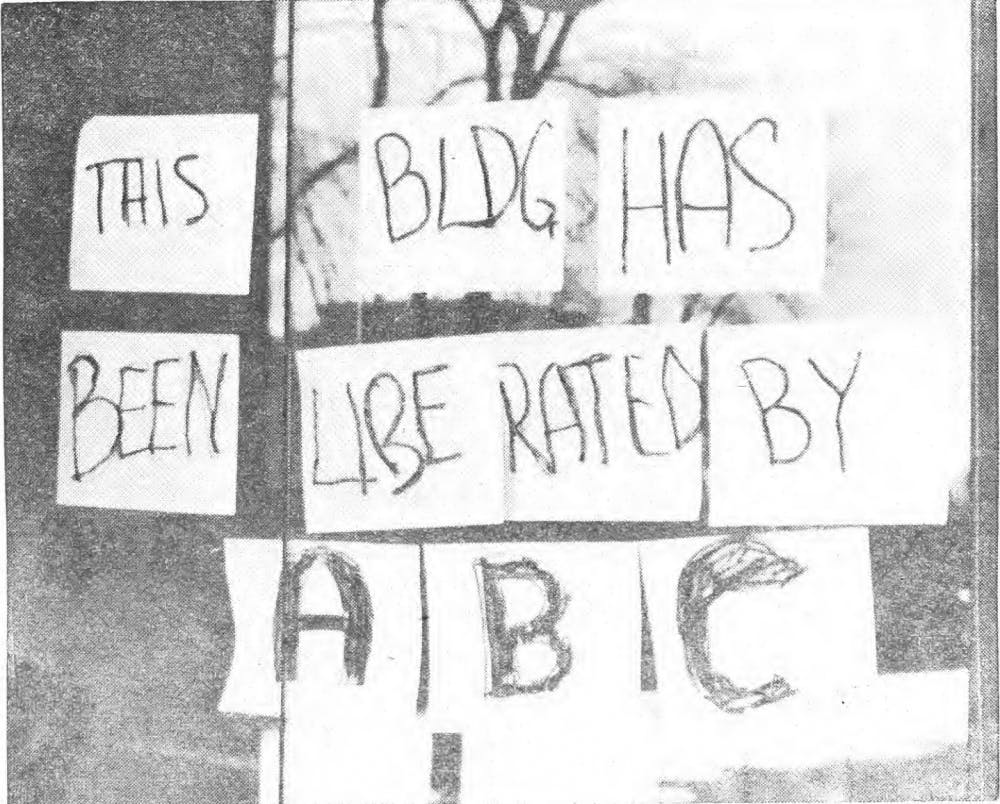At 7 a.m. on March 11, 1969, four students lurked in the weeds in front of the New South Building.
They were waiting for the janitor of the building to open the door before approaching him and telling him that he had the day off, according to Rod Hamilton ’69, a spokesperson for the protest and one of the students who had hid in the weeds that day.
Shortly afterwards, over 40 black students from the Association of Black Collegians (ABC) rushed the building, according to a log from the Department of Public Information. The students then chained the north doors of the building shut and secured the east doors with a mop.
In other words, The Daily Princetonian said at the time, the takeover of New South was “hitchless.”
These black student activists were protesting the University’s investment in companies that, in the eyes of Hamilton and his fellow students, were complicit in bolstering the apartheid regime in South Africa.
Merely a week earlier, on March 4, then-University president Robert Goheen ’40 had written in a statement that the University acknowledges the moral issue that such investments impose but also that broad and absolute restrictions cannot be accommodated. At the time, such investments totaled $127 million.
“Demands have been stated and restated and we feel that we have made ourselves clear on the issues,” the Committee on Black Awareness, Pan African Association, and ABC wrote in a response to Goheen’s decision. “We demand that you deal with us on the subject of South Africa NOW.”
A week later, they would occupy New South.
This protest at New South was a bookend to a decade full of change at the University. Just six years before, in 1963, Goheen announced a new admissions policy to accept as many qualified African-American students as possible.
One year later, in 1964, the University became the first predominantly white University to appoint a black administrator, Carl Fields. Paul Carryon ’68 and Alan Deane Buchanan ’68 co-founded the ABC, and they would hold their first conference in 1967.
The ABC would also hold a number of protests prior to that day. Hamilton described gathering a number of students into the pulpit of the Chapel for one protest, gathering students in Chancellor Green until sundown for another.
But, for this protest, student activists from the inside of New South would paste signs that said “Black is beautiful” and “This building has been liberated” on the windows, and they would shut out the 200 University employees that usually work at the building from entering.

Hamilton said he and other students chose the New South Building because it was very “defensible,” with only two entrances to cover.
Outside the building, Students for a Democratic Society — a multiracial student activist organization — “milled about the concourse,” leading their own demonstrations. The ABC allowed some female demonstrators from SDS to come into New South because of the high wind chill and freezing cold temperatures.

Students stand outside of New South during the seizure of New South in 1969. Source: The Daily Princetonian Larry Dupraz Digital Archives.
But, at noon, the white students present at the protest were asked to leave. Hamilton said that he and other black students wanted the protest to be “an ABC action.”
“We appreciated the support of other folks,” Hamilton said in an interview with the ‘Prince.’ “We wanted to have the people in the building be all from ABC.”
Within the same hour, Goheen released a statement on the occupation, warning that protestors were being disruptive to important University activities.
“This has occasioned stoppage on various critical activities including preparation of the bi-weekly pay-roll and work on the folders of applicants to the freshman class,” Goheen said. “Seizure of the New South Building places the students involved in it in clear violation of the University policy.”
Throughout the day, Dean Neil Rudenstine and Hamilton were in consistent communication through the phone in the New South elevator — the only phone in the building.
Rudenstine said the severity of the discipline would depend on how long students stayed in the building. According to Rudenstine, the Discipline Committee was called for 5 p.m. that day and would summon individual hearings.
If the administration received no response from the protestors, Rudenstine said, then they would take more serious action, like a court order or an injunction.
Despite the threats of disciplinary or legal action, the ABC students would continue to occupy the building until late in the evening. According to the ‘Prince’ at the time, five students were put on disciplinary probation for their involvement.
According to the ABC, they would eventually leave at 6:20 p.m. of their own accord, because they had accomplished the goals of “registration of disgust, dramatization of commitment, sensitization of the community to the issue.”

A guard for the New South demonstration opens the door for a protestor. Source: The Daily Princetonian Larry Dupraz Digital Archives.
That day, other protests were also taking place on other parts of campus in response to the New South takeover. Members of the Third World Liberation Front, a new organization of African, Asian, Latin American and American students, also participated and published a statement condemning University investment.
“We dissent from University activities and policies which in fact support the racist South African regime,” the statement said. “We reject the Goheen policy statement as apologetic and evasive. We trust the occupation of the building will accentuate the problem of U.S. support of South Africa’s apartheid system to a broader audience more forcefully than previously possible.”
Later in the evening, the SDS held a meeting of 250 people in McCosh 10. Undergraduate Government Assembly President Peter Kaminsky ’69, who spoke at the meeting, defended the actions of the protestors, describing their cause as “moral, rational, correct and logical.”
In their positions as students, Kaminsky said the effective measure was “the power of a united people.”
A letter released by the ABC that day further condemned the University’s investment and defended the occupation.
“We have demonstrated our willingness to work through those so called proper channels in the past, and have reached the conclusion that on this issue the University has decided to adhere to what is a purely immoral, illegitimate, and racist viewpoint,” the letter read.
“Our continued position as black people is that 127 million dollars is not worth one black life, one life,” the letter added.
Student reaction to the protest was mixed. A survey done later found that undergraduates backed Goheen’s stance on investment in a 2–1 margin, with 1604 of 3200 undergrads filling out the poll. 64 percent rejected occupation of administration or classroom buildings as a protest, and 76 percent rejected occupation for dissatisfaction with apartheid.
In an interview with the ‘Prince,’ Hamilton said that although the majority of the student body may not have supported the protest, the number that did were felt and appreciated.
Looking to the protest’s larger impact, Hamilton said that the New South occupation in particular “really took root.”
“I think it did change the University,” Hamilton said. “Generations of students took that issue close to their hearts and as one that should be pursued.”









